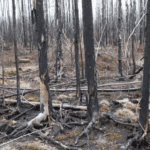A new paper published in the Canadian Journal of Forest Research addresses how to sustainably harvest timber while minimizing the impact on threatened woodland caribou.
To do so, researchers developed a model that assesses the financial trade-off between maximizing wildlife habitat protection and maximizing timber harvest revenues.
They applied their model to the Cold Lake Caribou Range of Alberta and hope the model can be used as a tool to inform forest management and wildlife conservation.
“There is an economic trade-off between implementing large-scale caribou protection measures and achieving forest management goals,” explained Denys Yemshanov, lead author of the study. “Ideally we want to satisfy both, but this may not be possible. There’s no free lunch. Something’s got to give, and this is what this model is about.”
Woodland caribou are listed as a threatened species both nationally in Canada and provincially in Alberta.
Much of the forestry activity in Alberta’s boreal forests involve clear-cutting patches of forest, which in turn fragments the caribou’s ideal habitat—problematic as caribou prefer large areas of undisturbed forest.
Human disturbances such as seismic lines, resource extraction, or clear-cutting make it easier for predators to access caribou. For caribou conservation, maintaining large, connected networks of undisturbed forest is key.
That’s why for their model, Yemshanov and colleagues maximized habitat connectivity for determining ideal habitat protection. The authors then linked the caribou connectivity model with a forest planning model.
Their new combined model maximizes revenue given different harvesting targets and estimates the financial cost of harvesting timber in two distinct scenarios: the first in which habitat protection is a priority and the second in which timber harvest is prioritized and caribou habitat protection is not. The timber supply cost difference between the two is then calculated given various harvesting quotas.
The researchers chose to apply this model in the Cold Lake Caribou Range in northern Alberta as a case study. The 6726-km2 range includes swathes of suitable caribou habitat as well as a sizeable area of disturbed habitat from natural resource extraction and forestry.
“I think we’re just in the beginning of this whole new process and we’re just scratching the surface. There’s so many things we could do with exploring the trade-offs between biological conservation and economic use of boreal landscapes,” said Yemshanov. “The notable aspect is that we tried to show how it can be done.”
Further research in this field can involve expanding the model to include more factors such as wildfire disturbances, road construction, protecting multiple additional species, or creating wildlife corridors. The model can also be applied to other regions in Canada.
Read the paper: Assessing the trade-offs between timber supply and wildlife protection goals in boreal landscapes in the Canadian Journal of Forest Research.




